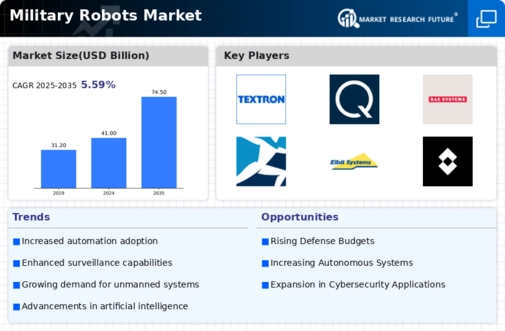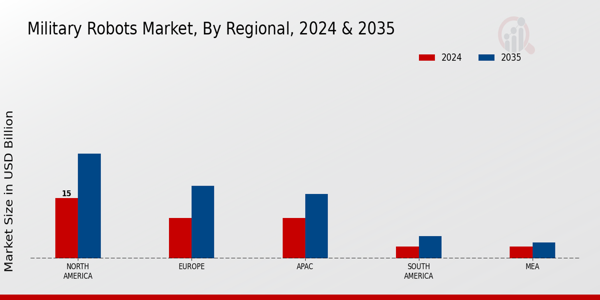Global Security Concerns
Global security concerns are a significant factor influencing the Global Military Robots Market Industry. Heightened geopolitical tensions and the emergence of new threats, such as cyber warfare and terrorism, are prompting nations to invest in advanced military technologies. The integration of military robots into defense strategies is seen as a viable solution to address these challenges. Countries are increasingly adopting robotic systems for border security, surveillance, and counter-terrorism operations. This focus on enhancing national security through technological innovation is expected to drive market growth, as governments seek to bolster their defense capabilities in response to evolving threats.
Increased Defense Budgets
The Global Military Robots Market Industry is experiencing growth driven by rising defense budgets across various nations. Countries are increasingly allocating substantial financial resources to enhance their military capabilities, with global military spending projected to reach 41.0 USD Billion in 2024. This trend reflects a strategic shift towards advanced technologies, including robotics, to improve operational efficiency and effectiveness. Nations such as the United States and China are leading this charge, investing heavily in unmanned systems for surveillance, reconnaissance, and combat roles. As defense budgets continue to expand, the demand for military robots is likely to surge, further propelling the market forward.
Market Growth Projections
The Global Military Robots Market Industry is poised for substantial growth, with projections indicating a market value of 74.5 USD Billion by 2035. This growth trajectory is supported by a compound annual growth rate (CAGR) of 5.59% from 2025 to 2035. The increasing integration of advanced technologies, coupled with rising defense budgets and global security concerns, is likely to drive demand for military robots across various applications. As nations continue to invest in innovative solutions to enhance their military capabilities, the market is expected to expand significantly, reflecting the evolving landscape of modern warfare.
Rising Asymmetric Warfare
The rise of asymmetric warfare is a critical driver of the Global Military Robots Market Industry. As conflicts become increasingly unconventional, military forces are adapting by integrating robotic systems to counter diverse threats. Unmanned aerial vehicles (UAVs) and ground robots are being deployed for intelligence, surveillance, and reconnaissance missions, allowing for enhanced operational capabilities in complex environments. This shift towards asymmetric warfare necessitates the use of advanced technologies, which military robots provide. The growing recognition of the effectiveness of these systems in modern combat scenarios is likely to drive demand, contributing to a projected CAGR of 5.59% from 2025 to 2035.
Technological Advancements
Technological advancements play a pivotal role in shaping the Global Military Robots Market Industry. Innovations in artificial intelligence, machine learning, and robotics are enhancing the capabilities of military robots, making them more efficient and effective in various operational scenarios. For instance, autonomous drones and ground robots are now equipped with advanced sensors and data analytics, enabling real-time decision-making and improved situational awareness. These advancements not only increase the operational effectiveness of military forces but also reduce the risk to human personnel. As technology continues to evolve, the market is expected to witness significant growth, with projections indicating a market value of 74.5 USD Billion by 2035.
Increased Demand for Unmanned Systems
The Global Military Robots Market Industry is witnessing a surge in demand for unmanned systems, driven by their operational advantages in various military applications. Unmanned aerial vehicles (UAVs) and ground robots are increasingly utilized for reconnaissance, surveillance, and combat operations, providing military forces with enhanced capabilities while minimizing risks to personnel. The growing recognition of the effectiveness of these systems in modern warfare is likely to fuel market expansion. As nations prioritize the development and deployment of unmanned technologies, the market is expected to experience robust growth, aligning with the projected increase in global military spending.






















